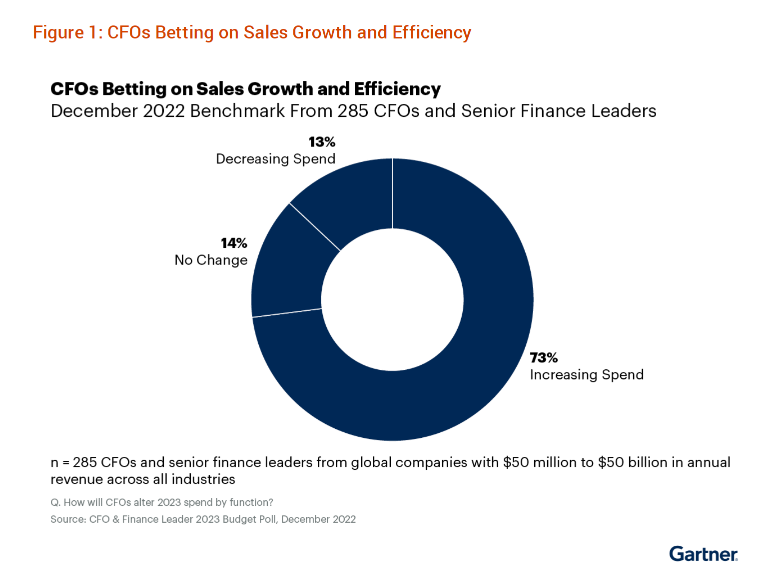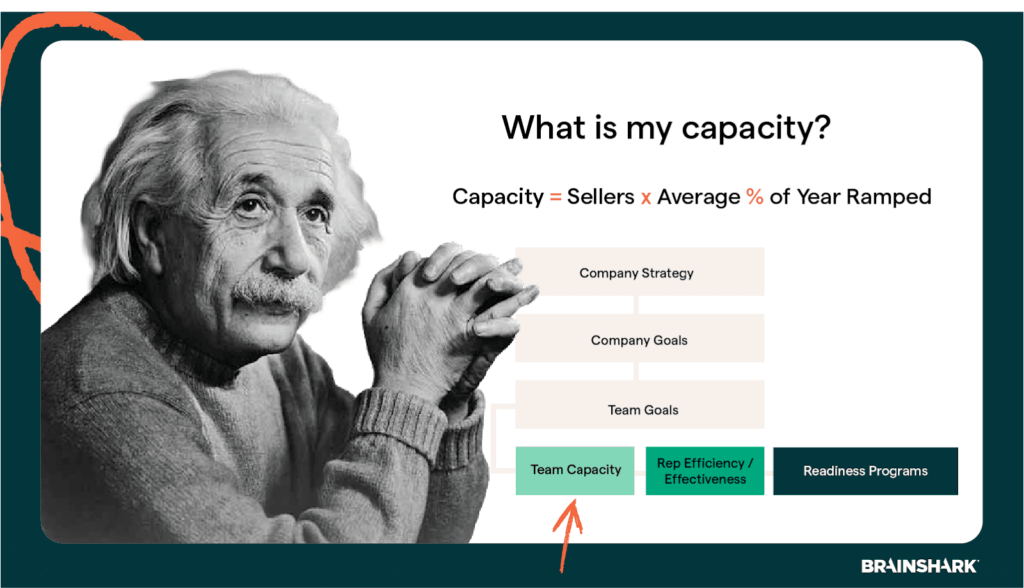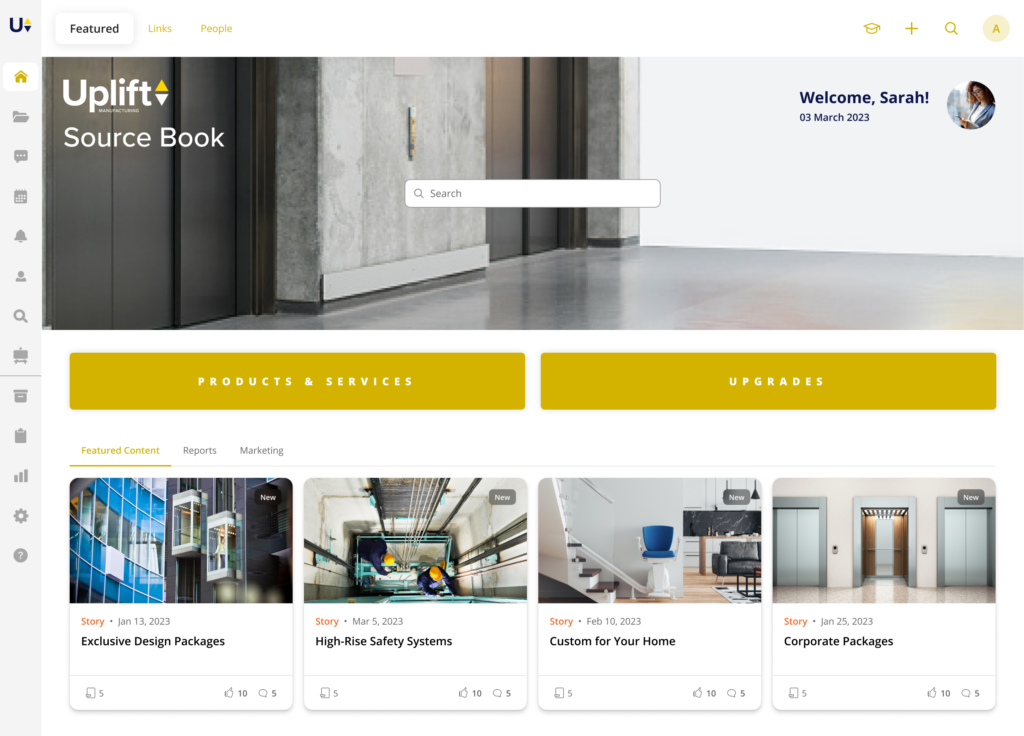High turnover in sales leaving quota vulnerable?
Lack of sales data complicating your financial forecasting and stakeholder reporting?
Inefficiencies and bad communication in your go-to-market teams affecting customer experience and revenue?
These are common problems for CFOs — and common reasons why revenue enablement technology has been deployed across enterprises of all sizes to “reduce internal friction and improve consistent messaging to customers” (Gartner 2023).
Let’s take a look at why investing in revenue enablement could be your most profitable move as CFO, as well as how you’ll determine your ROI and prove it to your board.
Why invest in revenue enablement technology?
As CFO, you need to make sure your company has the right talent, technology, and processes in place to support your financial goals and objectives — and revenue enablement sits at the intersection of all three.
Revenue enablement, also known as sales or business enablement, helps CFOs and CROs achieve and maintain operational efficiency for peak performance while aligning the entire organization around the customer for long-term brand growth and increases in customer retention, among other benefits, such as:
- Bigger deals
- Higher close rates
- Shorter sales cycles
- Faster time to competency/first sale for new hires
- Higher sales capacity/consistent coverage of the capacity gap
- Marketing/content efficiency and effectiveness
- Less time and effort wasted due to sales/marketing misalignment and lack of communication
All of which translate to higher, more predictable revenue, and reduced operating costs.
A Gartner sales survey featured in their 2023 Guide to Revenue Enablement “found that organizations focused on revenue enablement were more likely to exceed performance targets compared to those overfocused on enabling buyers” and “were at least 75% more likely to exceed performance targets such as seller revenue, cross-sell/upsell and revenue growth.”
At the close of 2022, Gartner also reported more CFOs were increasing spend on tools that aid sales growth and operational efficiency:

Considerations for your cost/benefit analysis of revenue enablement
Costs of revenue enablement
Software
Chief among the few costs of revenue enablement is of course the price of the software. And since most software these days is offered under a SaaS subscription model, there will be an annual cost to consider, which can be paid out yearly, monthly, or quarterly, depending on your contract.
Given that software pricing is so varied and often calculated based on your implementation and the size of your organization, you usually will not have a hard number to use in your analysis until you’ve met with the vendor and communicated your use case with them.
Human resources
You will need to consider which and how many of your staff will be assigned to manage the software. Keep in mind that this process will be “front loaded” with most effort taking place in the early stages of implementation, after which automation kicks in and the workflow settles into a more relaxed pace with maintenance becoming ad hoc.
Enablement providers also have service and support teams to assist you as needed to speed up and smooth out the process. If you run with a MVP you can be up and running in a matter of weeks, with many enablement users reporting full implementation in about three months.
Many organizations already have or hire a small sales enablement team who take on the software as part of their duties. Enablement teams commonly contain anywhere from one to five people, depending on the size of your sales force. According to SalesHood, “You should have one sales enablement person for every hundred employees.”
Another common practice is for the enablement tool to be a shared responsibility between IT (back-end), sales management, and marketing (front-end), with one or two people designated from each team.
Opportunity cost
Your ROI calculations must also consider the opportunity cost of not embracing a sales enablement strategy.
At this stage, it is likely your competitors already have an enablement initiative, and if your company does not there is an economic impact to that decision, or the lack of a decision, also called “status quo bias.”
The status quo that sales enablement solutions replace often consists of outdated legacy processes and tools, bloated and stale document management systems, and poor communication and data tracking — all of which represent leaks in your revenue pipeline.
Revenue enablement stops the flow of losses caused by your inefficient status quo.
Further reading: The cost of doing nothing — overcoming status quo bias in sales enablement
Opportunity cost alone may be all you need for investment justification in an enablement initiative.
Benefits of revenue enablement
“If a sales leader is looking to drive results and truly surpass KPIs, revenue enablement should be a top-of-mind consideration.” -Nate McCullough, Director, Advisory in the Gartner Sales Practice in How Revenue Enablement Helps Sales Organizations Exceed Performance Targets
Hard ROI of revenue enablement
- Improved sales and marketing performance with more accurate, real-time data and insights to report to stakeholders as part of financial planning.
 Brainshark Sales Scorecards
Brainshark Sales Scorecards - Reduced costs after improving the efficiency and effectiveness of your sales and marketing teams through better onboarding and training, streamlining workflows, and automating time-consuming processes.
- Reduced employee and customer churn which in turn, reduce acquisition cost and increase coverage of the sales capacity gap.

- Increased revenue with improved sales and marketing performance, providing real-time data and insights to stakeholders, and enabling better collaboration between teams without manual oversight, including the finance and sales teams.
Soft ROI of revenue enablement
- Improved customer experience from better service, faster response times, and more personalized interactions. This can lead to increased customer loyalty and retention.
- Increased employee satisfaction from better tools and resources to do their jobs. This can lead to increased productivity, better morale, and reduced turnover.
- Improved collaboration due to better communication tools and workflows, which leads to better teamwork, increased efficiency, and improved decision-making.

Custom Bigtincan workspace for a manufacturing company
- Better data management thanks to easy-to-use data analytics and reporting tools that span go-to-market activities from training to sales performance to content engagement.
- Improved brand reputation after enabling customer-facing teams to provide a higher standard of customer service, which results in word-of-mouth marketing and higher perceived product value which allows you to raise prices.
Enablement ROI metrics and formulas
The following metrics and formulas are key areas to measure to calculate your return on investment in revenue enablement. Before implementation, establish your current baseline for each of these and track improvement quarterly to demonstrate progress to your executive team and board.
- Cost per sale or CAC (customer acquisition cost)
- Sales cycle length
- Quota attainment
- QoQ revenue growth
- Training effectiveness
- Content usage and effectiveness
- Customer conversion rates
- Customer churn rate
- Seller churn rate
- Win rates
See also: The Definitive Guide to the Most Important Sales Enablement Metrics
Case studies — real results from enabled organizations
Across the spectrum of Bigtincan customers, both big and small, we hear how enablement technology has:
- Increased productivity
- Improved information accuracy
- Reduced overhead expense
- Generated more sales revenue
- Increased customer satisfaction and retention
- Reduced selling cycle times
- Created more compelling engagements with customers
- Reduced workforce training time while improving training effectiveness
- Had a significant dollar-impact to both the corporate top-line and bottom-line
Just take a look at the following results reported by some of our customers.
Allurion Technologies
For every dollar that we invest in professional education, the return on investment is around $8.50. We also know that clinics who go through our training journey are 67% more productive than those who don't.
-Matthew Wright, VP of Global Professional Education
850% ROI with professional education
67% more productive end users and resellers
OwnBackup
Our investors were pleased to see that we’ve capitalized on a platform to scale our L&D efforts and truly be able to measure and coach the effectiveness of our sales force.
-Thomas K. Cheriyan, Sales Enablement Manager
<1 month to first sale for new hires after implementation
Green Home Solar Systems
Bigtincan expands our reach by about 10x in terms of the number of customers. So if you do the math, that's increasing revenue by conservatively 40% on an annual basis.
-Managing Partner
40% increase in annual revenue
2x the amount of hours spent actively selling per day per sales rep
Digi International
2000% adoption of platform
182% quarterly revenue growth among key channel partners
Need help calculating your enablement ROI based on your particular business case? Speak to our team.
